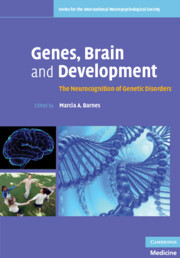Book contents
- Frontmatter
- Contents
- List of Contributors
- Preface
- Acknowledgments
- Section 1 Connecting genes, brain, and behavior in neurodevelopmental disorders
- 1 Intergenerational effects of mutations in the fragile X mental retardation 1 gene. Fragile X: A model of X-linked mental retardation and neurodegeneration
- 2 Autism: Genes, anatomy, and behavioral outcome
- 3 Development in spina bifida: Neurobiological and environmental factors
- Section 2 Genetic disorders and models of neurocognitive development
- Index
- References
1 - Intergenerational effects of mutations in the fragile X mental retardation 1 gene. Fragile X: A model of X-linked mental retardation and neurodegeneration
Published online by Cambridge University Press: 04 August 2010
- Frontmatter
- Contents
- List of Contributors
- Preface
- Acknowledgments
- Section 1 Connecting genes, brain, and behavior in neurodevelopmental disorders
- 1 Intergenerational effects of mutations in the fragile X mental retardation 1 gene. Fragile X: A model of X-linked mental retardation and neurodegeneration
- 2 Autism: Genes, anatomy, and behavioral outcome
- 3 Development in spina bifida: Neurobiological and environmental factors
- Section 2 Genetic disorders and models of neurocognitive development
- Index
- References
Summary
Introduction
There have been remarkable advances in genetics over the past decade including the sequencing of the human genome which was completed in 2003, 50 years after the discovery of the double-helix structure of DNA by Watson and Crick (Valle, 2004). These advances have furthered our understanding of many forms of mental retardation, including X-linked mental retardation of which fragile X syndrome (FXS) is the most common type.
There are approximately 30, 000 genes in the human genome, and approximately 1000 genes on the X chromosome. Over 200 of these genes on the X chromosome have been associated with mental retardation. The X chromosome has more genes associated with mental retardation than any other chromosome. Approximately 20–25% of all cases of mental retardation are X-linked. Because males only have one X chromosome, they are much more vulnerable to the effects of an abnormal gene on the chromosome. There are approximately 20% more males with mental retardation than females in the general population. In this chapter we will review the most common inherited cause of mental retardation and neurodegeneration; fragile X associated tremor/ataxia syndrome (FXTAS), the most common cause of ataxia in those over 50 years of age; and the fragile X mental retardation 1 gene (FMR1), the most common gene associated with X-linked mental retardation.
- Type
- Chapter
- Information
- Genes, Brain and DevelopmentThe Neurocognition of Genetic Disorders, pp. 3 - 18Publisher: Cambridge University PressPrint publication year: 2010
References
- 3
- Cited by



